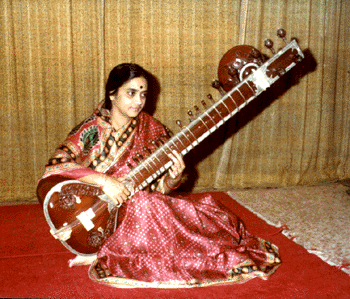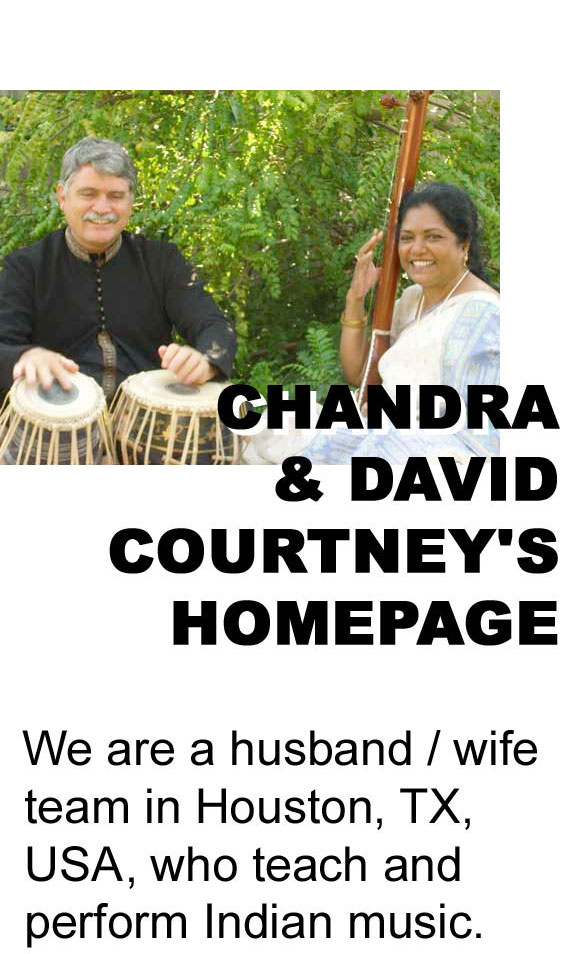SMT. MANJU MEHTA
Sitarist

SMT. MANJU MEHTA is a well known performer of the Indian sitar. She belongs to the very well known Bhatt family of Jaipur.
Her formal musical training is extensive. She had her training in sitar from Shri Shashi Mohan Bhatt, her elder brother. She won the Central and State Government scholarships and received training from Damodarlal Kabra and Pdt. Ravi Shankar. She won the coveted AIR Talent Search competition. She did her Masters of Music in which she cleared first class first.
Manju Mehta's professional career is impressive. She has performed in various places in India and abroad. She is a grade "A" artist on AIR and TV. She has 30 years of experience as a teacher in Jodhpur University and "Darpana" of Ahmedabad. She is presently teaching at the Saptak School of Music in Ahmedabad in which she is also a trustee.
REVIEWS
Excerpts from "Old Melody, New Order"
The Hindu - Friday, August 31, 2001
Prakash Wadhera
"Delhi's music lovers were very happy to listen to a polished sitar recital by Manju [Bhatt] Mehta of Ahmedabad. The sister of the late Shashi Mohan Bhatt, Manju had her training under her brother and then from the famous sarod player, the late D. L. Kabra of Jodhpur. Manju perfected her art under the family guru, Pandit Ravi Shankar. Today, one can say, she is an accomplished player.
Besides an inborn sense of the right note and intonation, Manju betrays a canny feeling for laya and tala that may be due to her family blood as much as to her teachers who excelled in both the ingredients of melody. However, there is another reason for her proficiency in the latter - her marriage to eminent percussionists Nandan Mehta of Ahmedabad.
Comparatively less known in this region, Manju seemed keen to make an impression on the Delhi listeners with whom she was naturally not as familiar as with her home listeners. This I sensed from her going in for an easy option in the choice of her raga Shyam Kalyan for the evening. It is a relatively work-a-day raga consisting of all sharp notes, capable of stirring one's imagination only up to a limit."
"The sense which had tuned the instrumented ever so sensitively succeeded in constructing a pervasive atmosphere of sur[note]. Shyam Kalyan lends itself to a lively moment and hence it is the favorite choice of musicians wishing to impress with their playing."
"Manju produced some swift sequences with arrested resonance of the strings. It sounded quite pleasant. A madhya laya composition in Jhap tala was followed by a fast one in Teen tala. Both these hilighted her impeccable understanding of the rhythm even as they displayed the competence of the tabla player versed in the Farukhabad style. The recital came to a conclusion with a lyrical dhun in Mishra Pilu."
First Lady of the Sitar
Miami New Times by Bob Tarte - Volume 14 Number 29 October 28-November 3rd, 1999
In Northern India instrumental music has traditionally been considered a male domain. Fathers pass on both their technical prowess and their acquired lore to their sons or closest male relatives. Until recently, women have been left out of the loop. "The one instrument where females have made some inroads is the sitar," says Manju Mehta, who speaks from personal experience. Mehta is one of Indian classical music's most renowned female sitaryas. "In amateur venues it is no longer uncommon for females to study and play the instrument. Even so, there are only a handful of female sitaryas who perform professionally."
Mehta initially attracts attention wherever she plays simply because she's a woman. But her amazing rhythmic control, coupled with the sheer beauty of her melodic inventions, quickly sweeps aside all other considerations. The essential artistry of Indian music is the ability to breathe life into the raga form, and Mehta most definitely has what it takes, earning the praise of many of India's classical leading lights. "She is a creative performer of exceptional caliber," warmly notes sarod player Usta Ali Akbar Khan.
Born into a musical family, Mehta took up the sitar at age thirteen, thanks in part to the influence of her "first guru," her eldest brother, Shashi Mohan Bhatt, then a student of Pandit Ravi Shankar. "Having a sitarist brother in the family, it was easy to pick the sitar as my main instrument," she says. Mehta's parents, Manhohan and Chandrakalav Bhatt, both accomplished musicians in their own right, enthusiastically encouraged Mehta and her siblings. "No matter what time of the day it was, there was always someone in the family practicing their music," she says of her childhood, recalling her younger brother Vishva Mohan Bhatt plucking away at his Hawaiian guitar and her nephew, Krishna Mohan Bhatt, trying his own hand at the sitar.
This familial devotion to music continues in Mehta's own clan. Her husband, Shri Nandan Mehta, is a top-notch tabla player and a disciple of Pandit Kishan Maharaj. Her older daughter, Purvi, plays sitar. Younger daughter Hetal plays tabla and will accompany Mehta (alongside tabla player Ustad Kadar Khan) during her Fort Lauderdale performance this Saturday.
With the help of artists such as Mehta, a new generation of female Indian musicians seems poised to break the chains of tradition, which for centuries saw women as lacking the proper qualities to master a musical instrument. "In Moghul times, the somber dhrupad style, essentially a vocal style with some instrumental accompaniment, was the leading genre in classical music," Mehta explains. "Dhrupad, which was mainly heard in royal venues, was entirely dominated by male musicians, both instrumentally and vocally." The rudra veena, a large fretted zither prominently featured in dhrupad, was played by and taught solely to the males in musical families. The lighter khyal style, which evolved in the Eighteenth Century, began to admit female vocalists, but not female instrumentalists.
Mehta continues: "Instrumental music was first derived from dhrupad, therefore men remained the primary exponents of such music. In addition to considerations of tradition, the technique and strength required for successful performance on traditional instruments is quite significant." Accordingly the same prejudiced rationalizations used to exclude women from certain male-dominated sports were also used against aspiring female musicians in India. "The ability to endure many hours of daily arduous practice necessary to attain proficiency was also considered the province of men," Mehta adds dryly.
Miron Leshem, a member of the board of directors of the Pembroke Pines-based Association of Performing Arts of India (which is sponsoring Mehta's local performance), has only the highest praise for the sitarya. He says the association has wanted Mehta to appear in South Florida for some time. Leshem describes Mehta's distinct style as one that "combines the tantrakari ang [instrumental-based style] with the gayaki ang [vocal-based style]. In the latter approach, the sitarist tries to imitate and capture the ornaments, grace notes, and microtonal inflections that give Indian music its character and beauty. Both her fixed compositions -- the gats -- and her improvisations are truly memorable."
Although Mehta bucked tradition to become a critically acclaimed professional sitarya, her playing, while innovative, never strays from the traditionalist path. "Unlike other instrumentalists, she does not introduce radical elements into her music, but nevertheless her instrumental 'voice' remains fresh and distinctive," says Leshem. "Manju never degenerates into mere pyrotechnics. The quality of her tone, the ability to be different within traditional confines, and her inherent musicality all combine to make her unique."
While being a female sitar player does set Mehta apart from the pack, "my contribution is not one associated with gender," she says. "Rather it's the ability to bring out the rasa, the emotional qualities of a particular raga, whether they be devotion, love, pathos, or joy."
The Ambience of the Afternoon
Times of India, Bombay, Thursday, Feb. 10, 1994
Manju Mehta, a serious sitarist from Ahmedabad, is an example of how many talented artistes like herself do not get the opportunities to be heard enough. By the time due recognition comes in the form of invitations, the artiste crosses his or her prime, or may be unable to refrain from playing to the gallery or to present truly mature and aesthetically appealing music.
Having received initial training from her brother, Shashi Mohan Bhatt and Damodarlal Kabra, Manju is now under the tutelage of Pt. Ravi Shankar.
Usually Afternoon melodies like Shuddha Sarang are not favorites of artists. Yet Manju's authoritative exposition of this melody deserves special mention.
The tantalizing touch of komal and teevra madhyam, with an anticipatory stay on rishabha and nishad, created a special afternoon ambience, with the theme developing in all its brightness. Her fondness for elaborate alaap, and imaginative jod is understandable, but what makes her stand apart is her quick manoeuvering through the limited jhala to two gats, thus avoiding repetition. Either way, the sequences were devoid of bombastic phrases.
Her short piece in Basant too was a breath of fresh air, devoid of gimmickry. The cascading and linear development, executed with grace, provided a perfect close to the concert: it was without din or fury and touched the heart. . . . .
Cultural Scene Warms Up
by Kishore Upadhyay - Times of India News Service
WOMEN TO THE FORE
The second day's programme all an all-women affair, with Mrs. Rupande Shah (vocal) and Mrs. Manju Mehta (sitar) both of Ahmedabad and Dr. Suhasini Koratkar (vocal) of Delhi regaling the audience with classical fare. Mrs. Manju Mehta makes rare public appearances, devoted to the pure music, for music school that she adheres. So it was a pleasant delight to connoisseurs and others alike to listen to the melodious notes of sitar. . . . .
Melodious End to Saptak Festival
by Sudhir Khandekar
On Saturday evening at Lion's Hall, Mithakhali, Saptaks's eight-day-long music festival came to a dignified conclusion with a melodious jugalbandhi between Manju Mehta (sitar) and Sultan Khan (Sarangi). . . . .
Manju Mehta and Sultan Khan displayed a keen sense of harmony when they played alaps in Chandranandan raga in a rising movement. . . .
Varied Fare at Vishnu Digambar Jayanti
Indian Express, New Delhi Monday Aug. 18, 1986
. . . . Manju Mehta, a sitarist new to Delhi audiences, gave a competent account of Jaunpuri. The raag was well chosen and thoroughly explored. The undercurrent of technical competence and clarity were evident as one would expect of a student of the maestro, Pt Ravi Shankar. . . . .
CONTACT
You can contact Manju Mehta at: apaiart@comcast.net
Streaming Videos
© 1998 - 2021 David and Chandrakantha Courtney
For comments, corrections, and suggestions, kindly contact David Courtney at david@chandrakantha.com
